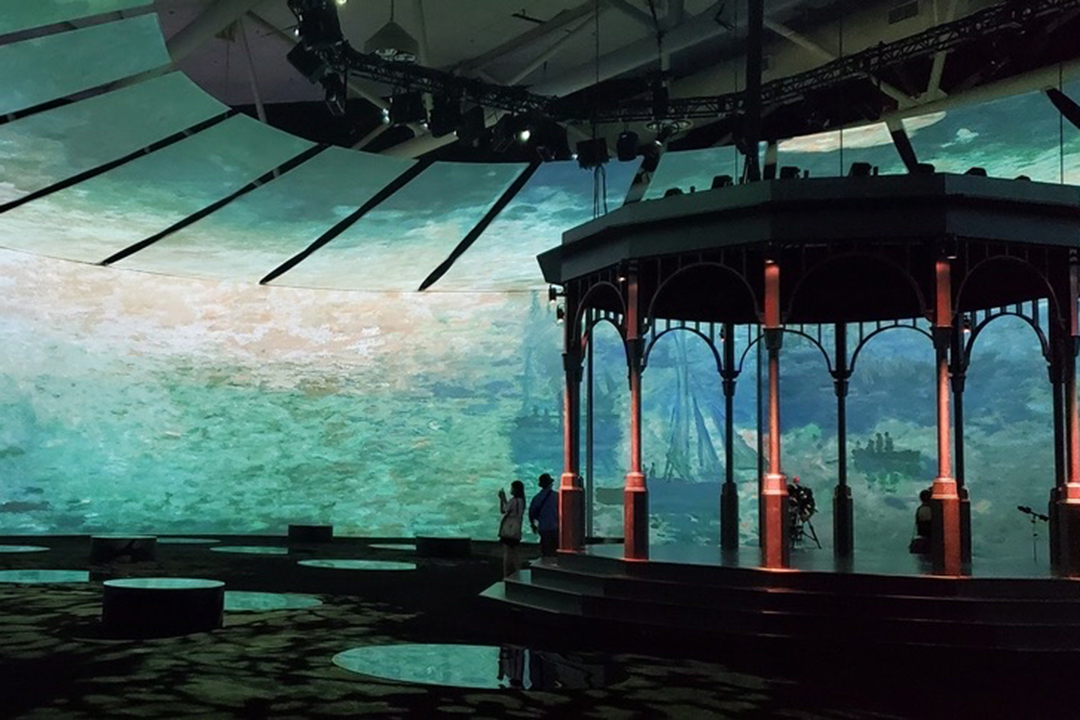It’s never clear what you’re getting into when you sign up for an ‘immersive’ exhibit. Sometimes, it means you’re in for an afternoon of breathtaking immersion; sometimes, it means you stand in a room of coloured LED lights and read a couple of signs.
In the case of Beyond Monet, an art exhibition hosted at the Metro Toronto Convention Centre that’s advertised as “Toronto’s most immersive experience,” it can be a bit of both.
The exhibit is designed to be an introduction to painter Claude Monet, regardless of how familiar viewers are with his life and works. Fanny Curtat, an art historian who worked on the exhibit, thinks that Monet’s work is often undermined because of its sheer ubiquity in our cultural consciousness.
“[Beyond Monet] provides an access for people who might think museums are not for them, to access this work differently. To see that [his paintings are] more than a chocolate box — to see that there’s more to [them],” said Curtat, in an interview with The Varsity.
And although it doesn’t always fulfill its promise of total audience immersion — there are places where paintings are lit to make them look washed out, or where glimpses of exposed ductwork remind you that you’re in the middle of a convention centre — it does a remarkably good job at showcasing the depth and breadth of Monet’s work in a way that feels fun and engaging.
The first room, which pays tribute to Monet’s iconic paintings of water lilies, isn’t terribly immersive. However, it seamlessly guides you through a primer on Monet’s personal life and philosophy.
The room is obviously structured around the information panels set up around the space, which belies the idea that Beyond Monet was designed to be accessible in a way most museums aren’t. To get the most out of your experience, the exhibit expects you to stand around reading a bunch of background information.
A tunnel full of hanging prismatic streamers leads into the real heart of the exhibit: the ‘Infinity Room.’ The gazebo at its center is surrounded on all sides by huge panels on which Monet’s work is directly projected. Circular mirrors on the ground give the impression of puddles left behind by the rain and reflect the colours of the scenery around them.
There’s a facet of Monet’s work that lends itself uniquely to the animation techniques used in the exhibit. Flashes of paintings flit across the screens in 360 degrees alongside quotes about impressionism from contemporary writers, presented in both French and English. The animation within each individual painting is relatively subtle, and doesn’t distract from the painting as a whole — instead, it often focuses on the natural movement contained within each scene.
The paintings aren’t in a particular chronological order — rather, they’re arranged so they craft a narrative together. When Curtat was writing out background information on Monet and selecting paintings to showcase, she says she tried to focus on bringing the ambience of his art to the foreground in order to allow the viewer to feel truly immersed in the scenes Monet’s work portrays.
“We’re so used to sharing our stories, our images on social media. [Monet’s work] was all about putting that forth and fighting with an institution to [go]: ‘No, your way of representing the world is artificial. I want to show what I see, what I feel.’ So he’s still very relevant in a lot of ways today,” she explained to The Varsity.
Rather than trying to reproduce reality, Monet was trying to capture his own perception of fleeting moments in time. That was also what he was trying to present in many of his paintings: moments so complete the audience could be drawn in. Water Lilies — perhaps one of his most famous works — was designed to take over entire rooms. Audiences could walk through it and feel as if they were in his garden, seeing the flowers for themselves. In that way, Beyond Monet seems very much to exhibit the spirit of Monet’s work.
Overall, the exhibit was an enjoyable experience. If you’ve been bemoaning the fact that you don’t spend enough time at museums as a university student and you want to immerse yourself in the Paris of Monet’s day, then Beyond Monet is a fun way to do it.
Is it worthwhile on a student budget? Probably not. At around a minimum of $36 per student ticket, it’s definitely an expensive outing. Of course, if you really want to embody Monet’s philosophy and appreciate life’s transience, there are plenty of inexpensive alternatives all around. Immersing yourself in his world will only get you so far — if you really want to emulate him, today’s Toronto has plenty of beautiful places where you can try to capture fleeting moments for yourself.


